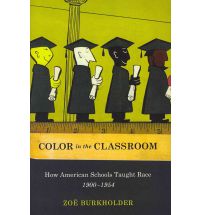 Zoë Burkholder (a recent Fordham/AEI “Emerging
Education Policy Scholar”) expounds in this book on a little-remembered, but still-felt
initiative of teachers to change the racial discourse in America. Prior to
WWII, Burkholder explains, racism was nation-based, often between various European
ethnic groups. Non-whites were largely invisible within society. During the war,
teachers—who started championing the ideal of tolerance—changed America’s concept
of race from nationality to color, in order to gain acknowledgment of
non-whites in society. Then after the war, teachers promoted a “color-blind”
society in which individuals were valued and identified for their talents and
cultural diversity instead of the color of their skin, shifting the conception
of race again, this time from color to culture. The book’s anecdotes and
explanations are valuable for their context; the book a smart window into
consequences of social molding through schooling.
Zoë Burkholder (a recent Fordham/AEI “Emerging
Education Policy Scholar”) expounds in this book on a little-remembered, but still-felt
initiative of teachers to change the racial discourse in America. Prior to
WWII, Burkholder explains, racism was nation-based, often between various European
ethnic groups. Non-whites were largely invisible within society. During the war,
teachers—who started championing the ideal of tolerance—changed America’s concept
of race from nationality to color, in order to gain acknowledgment of
non-whites in society. Then after the war, teachers promoted a “color-blind”
society in which individuals were valued and identified for their talents and
cultural diversity instead of the color of their skin, shifting the conception
of race again, this time from color to culture. The book’s anecdotes and
explanations are valuable for their context; the book a smart window into
consequences of social molding through schooling.
|
Zoë Burkholder. Color in the Classroom: How American Schools Taught Race 1900-1954, (Oxford University Press, New York, NY, 2011). |
